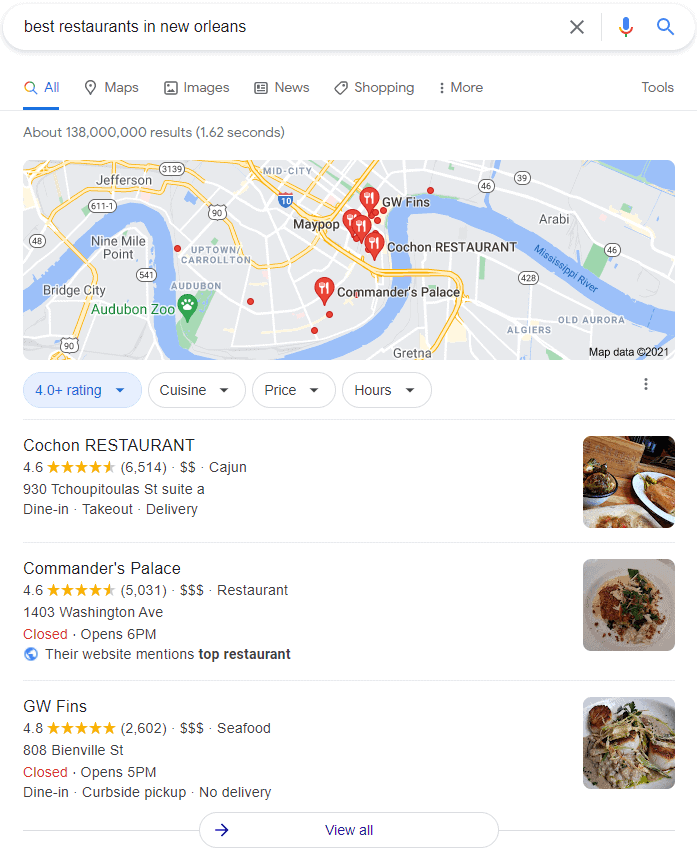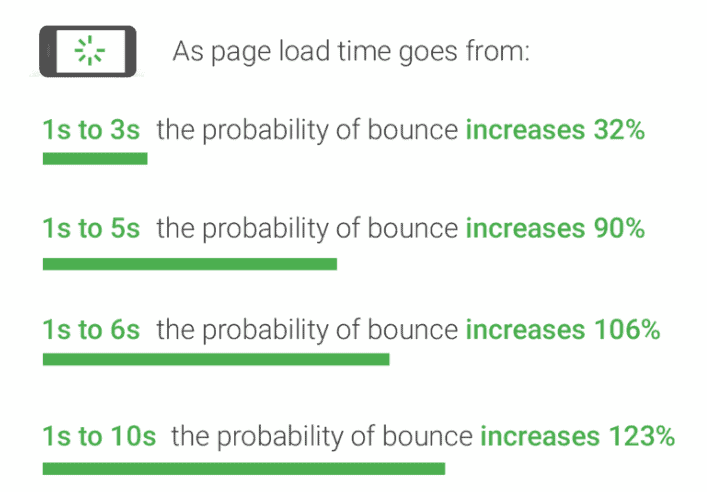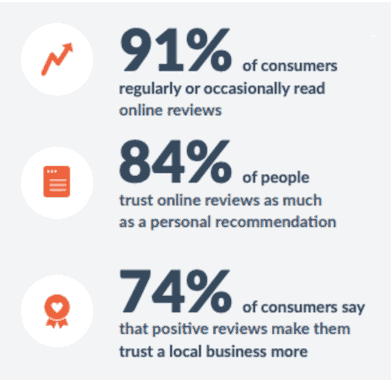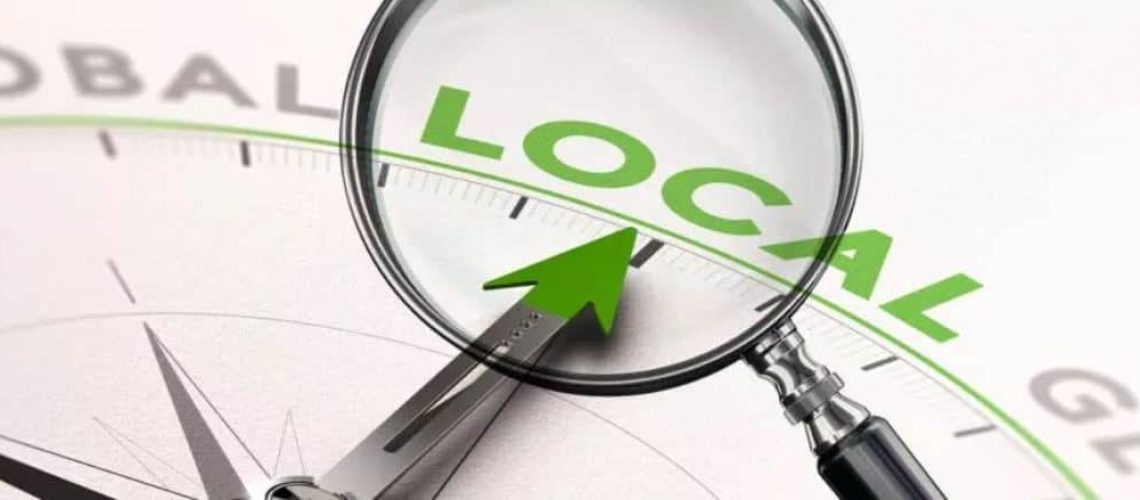
The most cost-effective method of increasing visibility in local search is Search Engine Optimization (SEO). Search engines drive 300 percent more traffic to sites than social media. There are a number of tactics that are relatively ineffective alone, however, when used together these SEO strategies will optimize a web page’s local ranking in the search results.
The following checklist of local SEO strategies will help businesses improve search engine results page (SERP) ranking over time.
- Optimize Google Business Profile (GBP)
- Build citations
- Build links
- Understand local SEO ranking factors
- Do keyword research
- Improve page loading speed
- Update metadata
- Request positive reviews
1. Optimize GBP
Google Business Profile is essential to business findability. It is the easy, essential first step to local SEO. It’s a free listing from Google that displays business information about a company — address and phone number, specialization, and direction on Google Maps. With a GBP account, clients can see and connect with customers, post updates to a business profile, and see how customers interact with a client’s business on Google.
When creating a GBP profile, a business should fill in as much information as possible. Google ranks these profiles based on their completeness and accuracy. GBP also provides information to Google Maps results and the Google local 3-Pack. This pack is a grouping of three local businesses that rank first when a local search is conducted for a specific type of business.

A GBP profile alone won’t improve SERP ranking. As a completely separate step that is easily missed, businesses need to create a GBP account in order to manage a profile or listing.
Given Google’s dominance in search (in June 2021, Google accounted for more than 87.76 percent of the global search engine market share), a GBP listing should be at the forefront of a digital marketing strategy since it immediately helps with SEO.
Since listings on GBP are one of the best ways to be found in local search, it is especially critical for local businesses that are competing with big commerce. On average, 56 percent of actions on GBP listings are website visits. This means GBP listings are the primary drivers of website traffic. Local citations and review management are other tactics that will increase local SEO of a local business.
Read: How to Optimize Google My Business for Local SEO
2. Build other local citations
A local citation is a physical building’s name, address, and phone number (NAP data) that appears in a local search. Besides GBP, there are other places for citations, including Bing Places and directory sites like Yellow Pages and Yelp.
It is extremely important in local search to claim and own all relevant citations. A business that doesn’t have local citations is unlikely to rank in local search. The more places that Google finds a business listed, the more relevance and authority that business will have on search.
There are a number of online services that manage local citations for client lists. For instance, BrightLocal, Vendasta, Moz Local, and Yext create, edit, and manage local citations on behalf of businesses. These SAAS products automate this step of local SEO.
The following shortlist of web directories/review sites for local businesses is a good starting point for listing creation.
- Yelp
- Bing Places for Business
- Yellow Pages
- Yahoo
- Foursquare
- ChamberOfCommerce.com
- Better Business Bureau
Read The Top 100 Business Directories for more information and local citation opportunities.
3. Build local backlinks
Local link building is another effective tactic for improving local SEO rankings. A backlink is a link from one website to another. There are a number of tactics that can be used to build a network of links that drive traffic back to your client’s website. Interestingly, it is actually easier for smaller local businesses to create backlinks than larger stores and franchises. This is because local businesses generally have the support of their community and can ask local papers, other businesses, or community groups for a backlink.
As a rule, websites you want to link with should have a “domain authority” score of 40 or higher so that Google will see it as a trusted source. Moz has a domain analysis tool that can determine the domain authority of websites. Another metric to look at is “domain rating” which can be measured using Ahrefs.
1. Outreach: The first and most important tactic in building new backlinks is outreach. Local businesses, communities, forums, bloggers, social media influencers, and newspapers are all viable sources that could potentially support clients with a backlink. It’s a numbers game, so reach out to as many sources as possible and remember that this is a continuous effort.
2. Find, fix, or eliminate broken links: Tools like Semrush, Google, and Ahrefs are available to assist with finding broken backlinks. Broken backlinks most likely belong to a web page that no longer exists and now show an error page when clicked. Another opportunity is to identify broken links belonging to a competitor. This way a business can reach out to the website hosting the broken link and provide their own content that covers the same topic.
3. Local sponsorship opportunities: Look for opportunities that line up with the business’s values. Local business clients might have a relationship with the local not-for-profit landscape or community groups that they can support. This can be something as small as donating an item to a silent auction, or as big as sponsoring an event. Such actions should help to create a new backlink opportunity.
4. Understand local SEO ranking factors
The following ranking factors are specific to local SEO and differ slightly from “regular” SEO. The importance of each is ranked according to the Google 3-Pack top ranking factors and local organic ranking factors. These should be optimized for improving local search ranking. The top four ranking factors in “regular” SEO are direct website visits, time on site, pages per session, and bounce rate. These also play a part in local SEO and are measurable metrics.

The below signals are indicators assessed by the Google algorithm for the above factors.
Link signals: The number and quality of those links are the two biggest signals that Google considers. It’s also a better signal if the website with the backlink is industry-specific and, of course, belongs to a local business.
On-page signals: Keywords are hugely important for on-page signals. Google looks for these in landing page titles and metadata/tags and considers the relevance of these keywords across a site. It is also important to update and optimize quality website content. According to a survey by Content Marketing Institute, 57 percent of marketing executives say on-page content development was the most effective SEO tactic.
Behavioral signals: Signals such as click-through rate, mobile clicks to call, and check-ins refer to user behavior and are important numbers to consider. These signals are not easily manipulated as they rely on consumer behavior.
Google My Business signals: GBP sets up a local business through Google Maps using signals like proximity, NAP data, categories, plus updated content like photos and reviews.
Citation signals: These signals include the consistency of NAP data across citations as well as the number of citations. Google considers popular directories and listing sites such as Yahoo, Bing Places, and Yellow Pages to be trustworthy and high-quality sources.
Personalization: Similar to behavioral signals, personalization is difficult to optimize for. It is based on the consumer’s language, browsing history, location, and the device they use to search.
Review signals: Signals include the number of reviews, keywords used, and the number of reviews that have text rather than just a star rating.
Social media signals: These signals include the volume of shares, likes, comments on social media platforms as well as mentions from community sites such as Reddit. With more people sharing and liking business pages, search engines have begun to include social signals as a factor in ranking. Google even has a partnership with Twitter that includes Tweets on the first page of search results.
5. Do keyword research
Keyword research helps businesses understand what consumers search for and how difficult it will be to rank for specific words and phrases. This is an ongoing endeavor as search language changes, new items are continually being searched for, and old products are phased out. Local SEO only makes sense if focused on the right keywords for your business.
When conducting a search, consumers type in keywords related to their search item. Google connects these search words to content a business puts online. Some keywords are extremely difficult to rank for because they are widely over-used. On the other hand, some keywords are ineffective because the number of searches conducted, also known as search volume, will be low for that term.
Further, there are different types of keywords. Long-tail keywords have the potential to rank easier because they are more specific than short-tail keywords that might have higher ranking competition. For example, a long-tail phrase might be “moderately inexpensive hotel with ocean view,” whereas a short-tail search might just be “hotel.” It’s important to find the right keywords to drive the right traffic to a website.
6. Improve page loading speed
A slow-loading webpage is synonymous with a high bounce rate. The longer it takes for a page to load, the more likely it is for visitors to close that page and search elsewhere. Speed is an important ranking signal, regardless of the device being used for the search. According to website setup, bounce rates are higher for mobile shoppers, compared to desktop users since an average web page takes approximately 88 percent longer to load on mobiles.

An optimized web page should take less than three seconds to load. Any longer than that and you run the risk of losing potential customers and reducing ranking potential. Google continues to increase consideration of the user experience for local SEO.
7. Update metadata
Metadata provides data or information about a blog post or a web page. The length of meta descriptions and title tags used is an important consideration for local SEO purposes.
Meta descriptions give details such as the elements of a page, structure, and content. These show up under the title in a search as the article or website description. According to WordStream, a meta description can be up to 725 characters, but 160 characters is ideal, since Google truncates to that length.

Title tags are similar to a headline, and when written correctly, they improve CTR and SERP ranking. All metadata should include keyword placement and an active tone of voice. The length of meta descriptions and title tags is key to SEO purposes. Ideally, title tags should be no more than 60 characters.
8. Request positive reviews
Increasing the number of online reviews is another tactic that can be combined with the rest to boost a web page ranking. The importance of positive reviews cannot be overstated with 74 percent of consumers stating that positive reviews build trust with local businesses.

Automated emails for online purchases can be used to request customer reviews. One can make it easier by including a link to a client’s GBP listing or Facebook page in the email. Automated review request emails can be periodically sent to a list of active customers as well as to buyers after each online purchase. Reviews can also be requested in-store by using a simple QR code at a payment station that takes customers to a GBP review page.
An increased ranking in search takes effort and patience. It can take approximately six months to rank on Google once the above tactics are put in place. But in the end, the effort pays off and businesses always benefit from local SEO strategies.
Reprinted with permission from Vendasta.


